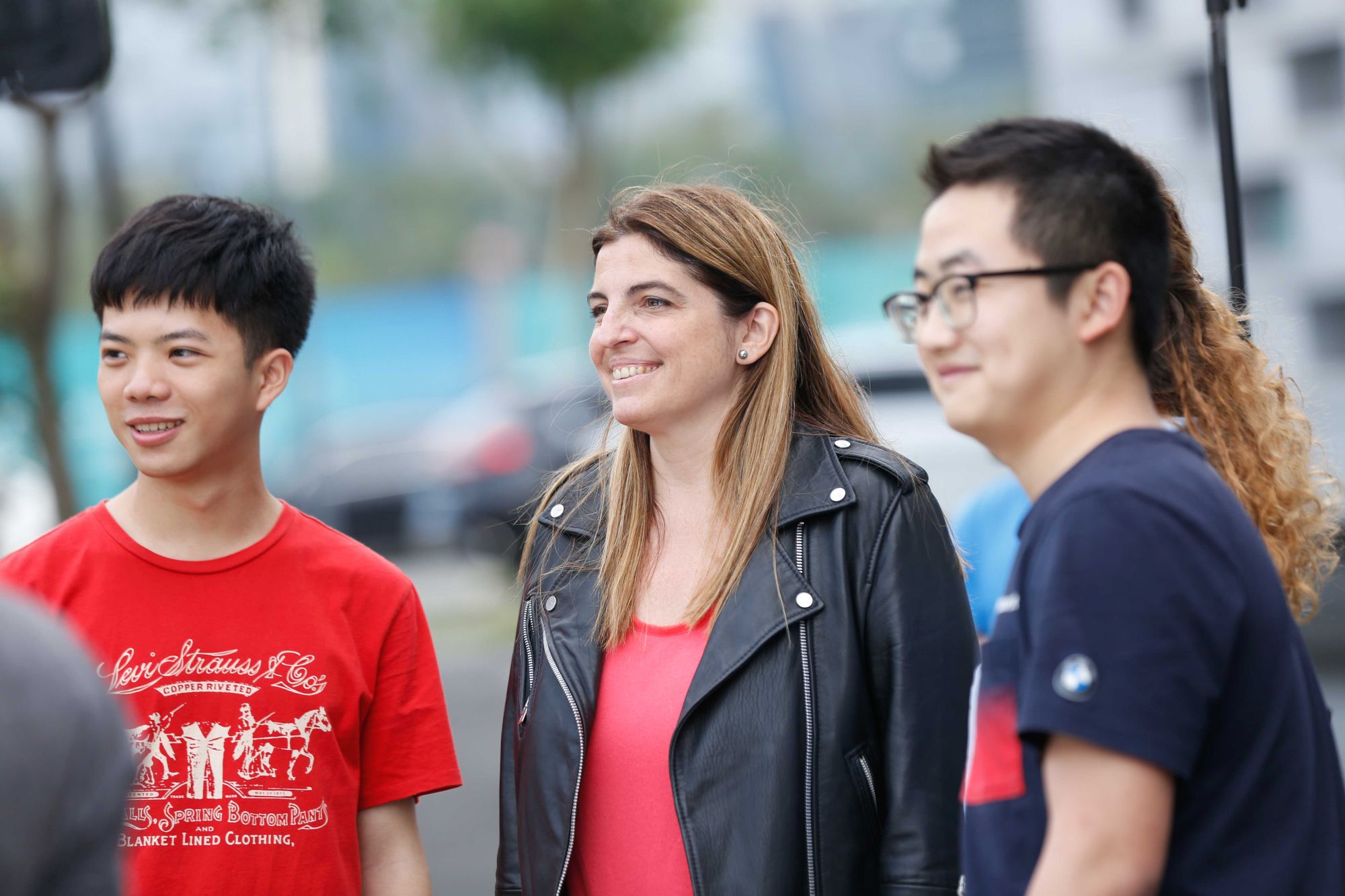漫步南科大校园,时不时会遇见一些成绩辉煌的“学术大牛”,让人心生敬仰,忍不住想和他们攀谈。出生在阿根廷、目前在南科大数学系任教授的雅娜·赫兹(Jana Hertz),就是其中一位。

雅娜接受采访
从乌拉圭共和国大学到南科大
赫兹曾是乌拉圭共和国大学的数学教授。乌拉圭共和国大学是乌拉圭最古老,规模最大的大学。她本科毕业于阿根廷罗萨里奥国立大学,随后于1999年在乌拉圭共和国大学完成了博士学位,并留校任教,从助理教授一直升到正教授。 2016年,赫兹决定来深圳,到南科大数学系担任教授。
赫兹的研究方向是动力系统,研究重点是双曲线动力学。她将自己的研究比喻为模拟气候现象,即研究难以预测的混乱系统,并试图量化正在发生的变化。
谈到自己为何会选择数学这条路,赫兹说,早在15岁时, 她就已很清楚自己想成为一名数学家,尽管那时候,“人们都不认为那是一个可以养家糊口的职业。”
一个15岁的少女为什么会知道自己想成为一名数学家?赫兹解释说,她一直喜欢抽象的东西。她记得自己在15岁时学到了多项式,虽然不明白一些符号的含义,却能理解背后的逻辑。 “这说来可能有点奇怪。但读懂数学的语言对我来说很容易。我知道得越多,学得越多,就越想深入了解,所以我从小就决定数学就是我要学习的东西,”她说,在这条路上,自己并没有什么“偶像”,只是像大多数的学者们一样,一直追随着数学领域的前人,不断前行。

“我是目前乌拉圭历史上唯一的女数学教授”
在许多国家和地区,人们普遍认为数学家应该是男性。当被问到身为女性是否给她带来了额外的压力时,赫兹表示否认,但也承认身为女性给她的工作增加了一定挑战性。
“据我所知,到目前为止,我是乌拉圭历史上唯一一个女性数学教授,”赫兹说。
她这句话让我们都愣住了,一时间竟然无语。细问之后,我们发现赫兹并没有因为自己“先驱者”的身份而感到压力。
鲜有人知道赫兹在职业生涯中取得的巨大成功。 2016年,她成为发展中国家女科学家组织(OWSD)在拉丁美洲和加勒比地区的副主席。该组织与教科文组织密切合作,旨在联合全世界的女科学家,加强女性在科技发展中的表率作用,凸显女科学家在国际科学技术发展中的影响。
我们好奇一个科学家什么时候才会知道自己成功了?赫兹说,她认为自己已经成功了,然而并不是因为自己获得的巨大成就。 “我认为自己是一个快乐的人,这就是成功。”她笑称。
在发展中国家女科学家组织发挥作用
赫兹教授称,加入发展中国家女科学家组织OWSD是一项很大的荣誉。但更重要的是,OWSD让她有机会到世界各地会见女科学家们。2018年10月,她前往印度参加了该组织的执行委员会会议。
赫兹将这份荣誉视为另一项挑战——一项“有趣的”挑战。她说自己像一个“网络建设者”,将拉丁美洲和加勒比地区的女科学家们联系起来。拉丁美洲是一个非常多样化的地域,由科学发达国家和欠发达国家共同组成,这也给工作带来了一些挑战。组织的工作重点是让更多女性获得进入科学界的知识和机会。建立这个网络可以让当地的女科学家们相互支持,重要性不言而喻。
参与国际理论物理中心公益项目
从2014年起,每年夏天赫兹都会前往意大利东北部小城里雅斯特(Trieste) 任教一个月,直到2019年。这是她参加的一个国际理论物理中心(ICTP)的公益教育项目,旨在帮助来自欠发达国家和发展中国家的学者们获得更多更国际化的学科知识。2017年和赫兹一起教课的有数学家Amy Wilkinson,Corinna Ulcigrai和Stefano Luzzatto 等,项目总共收到了来自全球各地一百个国家和地区的400份学生参加课程的申请。
“项目里有很多来自欠发达和发展中国家地区的女性学者,来自非洲和亚洲的尤其多。你们通常不会在欧洲的学术会议上看到这么多非洲和亚洲的面孔。”赫兹说。她很高兴在教授这堂课时可以与来自各大洲的人们进行工作互动。
最大挑战是人们没有意识到女科学家面临挑战
发展中国家的女性在科学界面临什么样的挑战?赫兹称,女科学家面对的最大挑战,是人们没有意识到女科学家会面临挑战。“当我开始尝试在乌拉圭做一些女性数学家小组时,我遇到的第一个问题是许多年轻女性认为并没有问题存在。”她说。
但赫兹觉得变化正在慢慢发生,女科学家们开始逐渐意识到工作中身为女性带来的挑战。“当女科学家们开始职业生涯时,身边同事的性别比例接近一比一,但是随着她们的不断升职,她们开始发现情况已经不再如前。”赫兹称自己就是一个典型的例子。学术高地缺少女性的身影,意味着少有女科学家担任决策职位,为其他女科学家争取权益。

鼓励发展中国家女性参与科学研究
在不论什么发展水平的社会中,STEM课程的学习都很重要,而谈到如何鼓励发展中国家的女性进入科学界时,赫兹提出了几个想法。
她认为,科学家们应该尽量平易近人,成为学生们的榜样。但她也承认,这个做法需要大量时间投入,而科学家们常常会因其他工作和义务无暇顾及。
还有一个建议是让学生们积极创建和编辑女科学家的百科页面。在这个过程中,学生们可以掌握百科页面编码方面的新技能,还必须按要求采访这些女科学家们,了解她们的研究成果。赫兹教授称,在西班牙语的百科网站中,只有大约20%的女科学家们有自己的页面。
鼓励女学生参加各种学术奥林匹克的项目也吸引了赫兹的注意。她称,男孩们的自信心普遍高于女孩们,而他们也更能自然而然地参加这些比赛和活动。如果有更多组织能够鼓励女孩们参加此类活动而不用担心做得不好,可能更多的女性会从小就习惯参与科学研究。
赫兹认为南方科技大学作为中国高等教育改革的一面旗帜,可以在鼓励女学生们参与科学研究方面发挥更多作用。她提议,让女学生们有机会多和女科学家见面交谈,一定会有所帮助。她认为学校提供了很多机会,让学生们了解到科学家的实际生活,而不是对科学家抱有刻板印象。她说,虽然“成为一名科学家”也许不是大部分女生的父母对孩子未来的期望,但事实上,科学家的生活也不像大家想象得那样死板。
“科学家也会经常旅行,也会痛快地玩,还会结识来自世界各地的朋友。我们研究我们喜欢的东西,我们的日程安排非常灵活。”赫兹说。
她给未来女科学家们的一句话是:不要放弃!